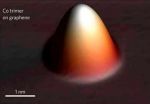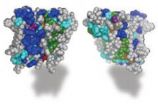(Press-News.org) Perhaps no other material is generating as much excitement in the electronics world as graphene, sheets of pure carbon just one atom thick through which electrons can race at nearly the speed of light – 100 times faster than they move through silicon. Superthin, superstrong, superflexible and superfast as an electrical conductor, graphene has been touted as a potential wonder material for a host of applications, starting with ultrafast transistors. For the vast potential of graphene to be fully realized, however, scientists must first learn more about what makes graphene so super. The latest step in this direction has been taken by researchers with the U.S. Department of Energy (DOE)'s Lawrence Berkeley National Laboratory (Berkeley Lab) and the University of California (UC) Berkeley.
Michael Crommie, a physicist who holds joint appointments with Berkeley Lab's Materials Sciences Division and UC Berkeley's Physics Department, led a study in which the first direct observations at microscopic lengths were recorded of how electrons and holes respond to a charged impurity – a single Coulomb potential – placed on a gated graphene device. The results provide experimental support to the theory that interactions between electrons are critical to graphene's extraordinary properties.
"We've shown that electrons in graphene behave very differently around charged impurities than electrons in other materials," Crommie says. "Some researchers have held that electron-electron interactions are not important to intrinsic graphene properties while others have argued they are. Our first-time-ever pictures of how ultra-relativistic electrons re-arrange themselves in response to a Coulomb potential come down on the side of electron-electron interactions being an important factor."
Crommie is the corresponding author of a paper describing this study published in the journal Nature Physics. The paper is titled "Mapping Dirac quasiparticles near a single Coulomb impurity on graphene." Co-authoring this paper were
Yang Wang, Victor Brar, Andrey Shytov, Qiong Wu, William Regan, Hsin-Zon Tsai, Alex Zettl and Leonid Levitov.
Graphene sheets are composed of carbon atoms arranged in a two-dimensional hexagonally patterned lattice, like a honeycomb. Electrons moving through this honeycomb lattice perfectly mimic the behavior expected of highly relativistic charged particles with no mass: think of a ray of light that is electrically charged. Because this is the same behavior displayed by highly relativistic free electrons, charge-carriers in graphene are referred to as "Dirac quasiparticles," after Paul Dirac, the scientist who first described the behavior of relativistic fermions in 1928.
"In graphene, electrons behave as massless Dirac fermions," Crommie says. "As such, the response of these electrons to a Coulomb potential is predicted to differ significantly from how non-relativistic electrons behave in traditional atomic and impurity systems. However, until now, many key theoretical predictions for this ultra-relativistic system had not been tested."
Working with a specially equipped scanning tunneling microscope (STM)in ultra-high vacuum, Crommie and his colleagues probed gated devices consisting of a graphene layer deposited atop boron nitride flakes which were themselves placed on a silicon dioxide substrate, the most common of semiconductor substrates.
"The use of boron-nitride significantly reduced the charge inhomogeneity of graphene, thereby allowing us to probe the intrinsic graphene electronic response to individual charged impurities," Crommie says. In this study, the charged impurities were cobalt trimers constructed on graphene by atomically manipulating cobalt monomers with the tip of an STM."
The STM used to fabricate the cobalt trimers was also used to map (through spatial variation in the electronic structure of the graphene) the response of Dirac quasiparticles – both electron-like and hole-like – to the Coulomb potential created by the trimers. Comparing the observed electron–hole asymmetry to theoretical simulations allowed the research team to not only test theoretical predictions for how Dirac fermions behave near a Coulomb potential, but also to extract graphene's dielectric constant.
"Theorists have predicted that compared with other materials, electrons in graphene are pulled into a positively-charged impurity either too weakly, the subcritical regime; or too strongly, the supercritical regime," Crommie says. "In our study, we verified the predictions for the subcritical regime and found the value for the dielectric to be small enough to indicate that electron–electron interactions contribute significantly to graphene properties. This information is fundamental to our understanding of how electrons move through graphene."
INFORMATION:
This research was supported by the DOE Office of Science, the
Office of Naval Research, and the National Science Foundation.
Lawrence Berkeley National Laboratory (Berkeley Lab) addresses the world's most urgent scientific challenges by advancing sustainable energy, protecting human health, creating new materials, and revealing the origin and fate of the universe. Founded in 1931, Berkeley Lab's scientific expertise has been recognized with 13 Nobel prizes. The University of California manages Berkeley Lab for the U.S. Department of Energy’s Office of Science.
A direct look at graphene
Direct imaging by Berkeley Lab Researchers confirms the importance of electron-electron interactions in graphene
2012-08-02
ELSE PRESS RELEASES FROM THIS DATE:
Global health researchers urge integrating de-worming into HIV care in Africa
2012-08-02
HIV care centers are an important and highly accessed point of care for HIV-infected children and their families in sub-Saharan Africa, but opportunities to address other health issues are being missed. Proven interventions, including routine deworming among young children, could be effectively integrated into HIV care according to a newly published article in PLoS by University of Washington researchers.
The article, "Integration of Deworming into HIV Care and Treatment: A Neglected Opportunity," estimates that millions of HIV-infected individuals in sub-Saharan Africa ...
UCLA-led project aimed at African American couples affected by HIV gets $2.5 million boost
2012-08-02
A UCLA-led project to implement a unique HIV intervention program aimed at reducing sexually risky behaviors and promoting healthier living among heterosexual African American couples has received a $2.5 million grant from the National Institute of Mental Health.
The program, based on Eban — a Yoruban concept from West Africa that symbolizes "safety, security and love within one's family and community" — is designed not only to reduce the risk of HIV and other sexually transmitted diseases but to increase couples' ability to communicate with each other, make safer behaviors ...
Is it a rock, or is it Jell-O? Defining the architecture of rhomboid enzymes
2012-08-02
Johns Hopkins scientists have decoded for the first time the "stability blueprint" of an enzyme that resides in a cell's membrane, mapping which parts of the enzyme are important for its shape and function. These studies, published in advance online on June 14 in Structure and on July 15 in Nature Chemical Biology, could eventually lead to the development of drugs to treat malaria and other parasitic diseases.
"[It's] the first time we really understand the architectural logic behind the structure of the enzyme," says Sinisa Urban, Ph.D., an associate professor of molecular ...
Mending a broken heart -- with a molecule that turns stem cells into heart cells
2012-08-02
LA JOLLA, Calif., August 2, 2012 – For years, scientists have been looking for a good source of heart cells that can be used to study cardiac function in the lab, or perhaps even to replace diseased or damaged tissue in heart disease patients. To do this, many are looking to stem cells. Researchers at Sanford-Burnham Medical Research Institute (Sanford-Burnham), the Human BioMolecular Research Institute, and ChemRegen, Inc. have been searching for molecules that convert stem cells to heart cells for about eight years—and now they've found one. Writing in the August 3 issue ...
Genetic copy-number variants and cancer risk
2012-08-02
Genetics clearly plays a role in cancer development and progression, but the reason that a certain mutation leads to one cancer and not another is less clear. Furthermore, no links have been found between any cancer and a type of genetic change called "copy-number variants," or CNVs. Now, a new study published by Cell Press in The American Journal of Human Genetics on August 2 identifies CNVs associated with testicular cancer risk, but not with the risk of breast or colon cancer.
Some cancers, including breast and colon cancer, are caused by mutations that are passed ...
It's in our genes: Why women outlive men
2012-08-02
Scientists are beginning to understand one of life's enduring mysteries - why women live, on average, longer than men.
Published today in Current Biology, research led by Monash University, describes how mutations to the DNA of the mitochondria can account for differences in the life expectancy of males and females. Mitochondria, which exist in almost all animal cells, are vital for life because they convert our food into the energy that powers the body.
Dr Damian Dowling and PhD student, Florencia Camus, both from the Monash School of Biological Sciences, worked with ...
'Unhealthy' changes in gut microbes benefit pregnant women
2012-08-02
The composition of microbes in the gut changes dramatically during pregnancy, according to a study published by Cell Press in the August 3rd issue of the journal Cell. Although these changes are associated with metabolic disease under most circumstances, they could be beneficial in pregnant women.
"This is the first in-depth characterization of the gut microbiota associated with pregnancy," says senior study author Ruth Ley of Cornell University. "The findings suggest that our bodies have coevolved with the microbiota and may actually be using them as a tool—to help alter ...
Scripps Florida scientists identify a critical tumor suppressor for cancer
2012-08-02
JUPITER, FL – August 2, 2012 – Scientists from the Florida campus of The Scripps Research Institute have identified a protein that impairs the development and maintenance of lymphoma (cancer of the lymph nodes), but is repressed during the initial stages of the disease, allowing for rapid tumor growth.
While the study, published in the August 3, 2012 edition of the journal Cell, largely focuses on the role of this new tumor suppressor in lymphoma induced by Myc oncoproteins (the cancer-promoting products of Myc oncogenes), the authors show this circuit is apparently operational ...
Study finds mechanism that turns white fat into energy-burning brown fat
2012-08-02
New York, NY (August 2, 2012) — Columbia University Medical Center (CUMC) researchers have identified a mechanism that can give energy-storing white fat some of the beneficial characteristics of energy-burning brown fat. The findings, based on studies of mice and of human fat tissue, could lead to new strategies for treating obesity and type 2 diabetes. The study was published today in the online edition of the journal Cell.
Humans have two types of fat tissue: white fat, which stores excess energy in the form of triglycerides, and brown fat, which is highly efficient ...
Research shows how protein component that enables cell replication gets ferried to chromosome tips
2012-08-02
STANFORD, Calif. — Stem cells are special. Nestled in muscle and skin, organ and bone, they bide their time over years or decades until called to replace damaged or lost tissue. One secret to their longevity is an enzyme called telomerase, which stills the relentless ticking of the molecular clock that limits the life span of other cells.
This cellular fountain of youth prevents the progressive shortening of the tips of our chromosomes that occurs with each cell division. But the presence of telomerase can be a double-edged sword: The same activity that ensures long life ...
LAST 30 PRESS RELEASES:
Could hidden infections be fueling long COVID?
Targeted oxygen for initial resuscitation of preterm infants
Researchers develop models to help diagnose ALS earlier through blood biomarkers
Jeonbuk National University researchers develop novel eco-friendly and photo-switchable smart adhesives
Magnetic ordering induces Jahn–Teller effect in spinel-type compounds
A mitochondrial protein may hold the secret to longevity, new study finds
Study shows how everyday repairs sustain autonomy in a Japanese squat
Ancient manatee relative reveals that sea cows have engineered the Arabian Gulf’s seagrass ecosystems for over 20 million years
Fecal tests reveal active termite attacks
Uterine fibroids linked to elevated heart disease risk
Dual use of cigarettes and vapes can reduce risks of smoking and help smokers quit
New bioelectronics device based on hydrogel- elastomer conductive nanomembranes
More yield through heterosis: IPK research team decodes gene interaction
James Webb telescope reveals spectacular atmospheric escape
ICE-CSIC leads a pioneering study on the feasibility of asteroid mining
Dramatic rise in young people using mental health services
Be careful trusting TikTok for gout advice
A study by the University of Seville links the vanishing of the specific heats at absolute zero with the principle of entropy increase
Anxiety and insomnia may lower natural killer cell count, potentially repressing immune function
How parasitic, asexual plants evolve and live
Research spotlight: A subset of patients with depression could benefit from anti-inflammatory treatment
New fully digital design paves the way for scalable probabilistic computing
Membrane electrode assembly design for high-efficiency anion exchange membrane water electrolysis
U.S. debt ceiling disputes show measurable impact on global crude oil markets
Climate extremes triggered rare coral disease and mass mortality on the Great Barrier Reef
Direct observation reveals “two-in-one” roles of plasma turbulence
Humans rank between meerkats and beavers in monogamy ‘league table’
US fossil reveals early mass-burial event and ancient microbial attack
Sedative choice could improve outcomes for breathing tube patients
New superconducting thin film for quantum computer chips
[Press-News.org] A direct look at grapheneDirect imaging by Berkeley Lab Researchers confirms the importance of electron-electron interactions in graphene



